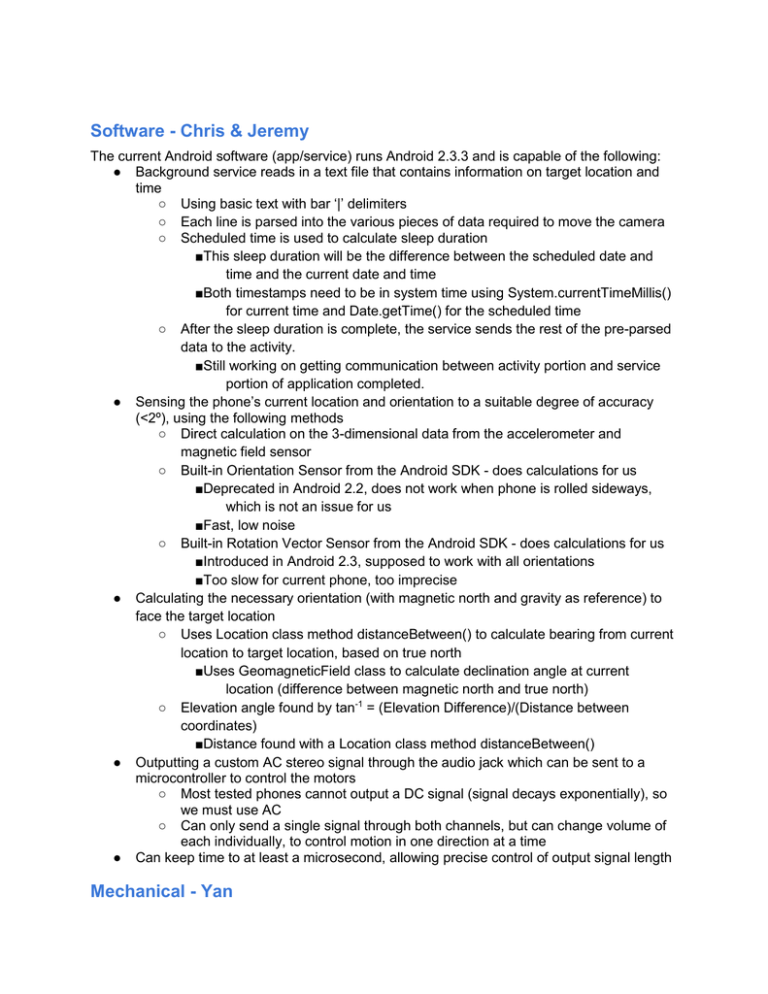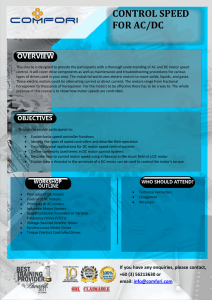Software - Chris & Jeremy
advertisement

Software - Chris & Jeremy The current Android software (app/service) runs Android 2.3.3 and is capable of the following: ● Background service reads in a text file that contains information on target location and time ○ Using basic text with bar ‘|’ delimiters ○ Each line is parsed into the various pieces of data required to move the camera ○ Scheduled time is used to calculate sleep duration ■This sleep duration will be the difference between the scheduled date and time and the current date and time ■Both timestamps need to be in system time using System.currentTimeMillis() for current time and Date.getTime() for the scheduled time ○ After the sleep duration is complete, the service sends the rest of the pre-parsed data to the activity. ■Still working on getting communication between activity portion and service portion of application completed. ● Sensing the phone’s current location and orientation to a suitable degree of accuracy (<2º), using the following methods ○ Direct calculation on the 3-dimensional data from the accelerometer and magnetic field sensor ○ Built-in Orientation Sensor from the Android SDK - does calculations for us ■Deprecated in Android 2.2, does not work when phone is rolled sideways, which is not an issue for us ■Fast, low noise ○ Built-in Rotation Vector Sensor from the Android SDK - does calculations for us ■Introduced in Android 2.3, supposed to work with all orientations ■Too slow for current phone, too imprecise ● Calculating the necessary orientation (with magnetic north and gravity as reference) to face the target location ○ Uses Location class method distanceBetween() to calculate bearing from current location to target location, based on true north ■Uses GeomagneticField class to calculate declination angle at current location (difference between magnetic north and true north) ○ Elevation angle found by tan-1 = (Elevation Difference)/(Distance between coordinates) ■Distance found with a Location class method distanceBetween() ● Outputting a custom AC stereo signal through the audio jack which can be sent to a microcontroller to control the motors ○ Most tested phones cannot output a DC signal (signal decays exponentially), so we must use AC ○ Can only send a single signal through both channels, but can change volume of each individually, to control motion in one direction at a time ● Can keep time to at least a microsecond, allowing precise control of output signal length Mechanical - Yan The mount has been designed to meet or exceed (*) all of the requirements from the Air Force Research Lab including: ● Azimuthal rotation range from 0 to 720 degrees* (twice the required) ● Polar elevation range of 0 to 180 degrees* (twice the required range) ● Securing a 30 lbs load. The camera and its optics are 22 lbs. ● Slot for android camera phone in order to use its camera to capture contextual imagery ● Selection of a budget efficient motor that can rotate the camera 180 degrees in any direction within 10 seconds *. A stepper motor was selected despite its high power consumption due to its accuracy, reliability and holding torque. The camera was designed completely in Autodesk Inventor ®. All centers of inertia, centers of mass and rotational torque present in operation of the mount were hand-calculated and confirmed accurate with Inventor’s simulation environment. All parts for the construction of the mount and its mechanical / electro-mechanical components were within a $200 dollar project as expected in the pre-proposal. This includes ● Stepper-motors and their required control boards - $83.80 ● Heat sinks for stepper-mottor controllers - $7.89 ● Flange bearings and ball bearings - $33.49 ● Gears - $34.47 ● All wood, metal, rods, pipes - $0.00 A total of $159.74 Wiring issues when setting up one of the motors has resulted in the destruction of 1 control board. A new board has been ordered at the price of $22.95 + educational discounts. We should still have ~$20.00 in this section. The construction of mechanical components have begun. Members involved in construction include: Austin, Jeremy and Yan. However due to scheduling constraints and the recent onslaught of exams/labs/projects in the two week’s leading up to spring break, the mount construction is not finalized. This is to be finalized ASAP. Electro - Mechanical - Austin & Ryan The control mechanism for the mount is currently capable of the following: ● Recieving AC input from audio jack ● Rectifying the signal into a DC signal the logic circuitry can use ● Pass the DC signal to the PIC microcontroller ○ The PIC can determine the voltage of the incoming DC signal to a high degree of accuracy ○ The PIC outputs control bits on seperate pins based on different values of the DC voltage ● The output pins are ready to be attached to the motor controller and stepper motors ● The motor controller and steppers motors are operational, but are still in need of a sufficient dedicated power supply. ● The motor controller CLEARLY cannot handle turning off a motor while it is running (we destroyed one). Exploration into other options to enable/disable the motors is ongoing. The current solution is to have the motors and controllers constantly on. This uses close to 160w, without even moving. Thus power efficiency, heat, and reliability are a concern. Power supply - Austin ● ● Initial ideas for the power supply are being explored and discussed. ○ Idea one is to daisy chain ATX computer power supplies to give a highly reliable, high quality solution that would produce power close to what is ideal for peak motor torque, though cost presents a potential issue. ○ Idea two is to use an xbox 360 power supply and a boost converter to get close to 30v from the regular 12v output of the power supply. This supply also promises to require less modification and is much cheaper. ○ Idea three is to create a power supply for the project from scratch. Ideally each of our motors would use 2A at 30V, which is not in a typical range for commercial products. This would require circuit design and may cause problems with reliability, depending on how well our design works. Other issues include; 5v required for the pic, 15v required for the op-amps, and 30v required for the motor/controllers ○ Our motor controller is capable of outputting a 5v signal to power the microcontroller, that will in turn, feed signal to the motor controller Webpage - Ryan The webpage for our project is completed and is uploaded to the class web space. It is available at: http://www.egr.msu.edu/classes/ece480/capstone/spring12/group03/index.html The information on the webpage includes: ● All team members and their roles ● All documents we have produced thus far including presentation slides ● A description of our project and some background information ● A media section for us to post any images or videos we take during the course of our project ● A timeline of our work including major milestones





